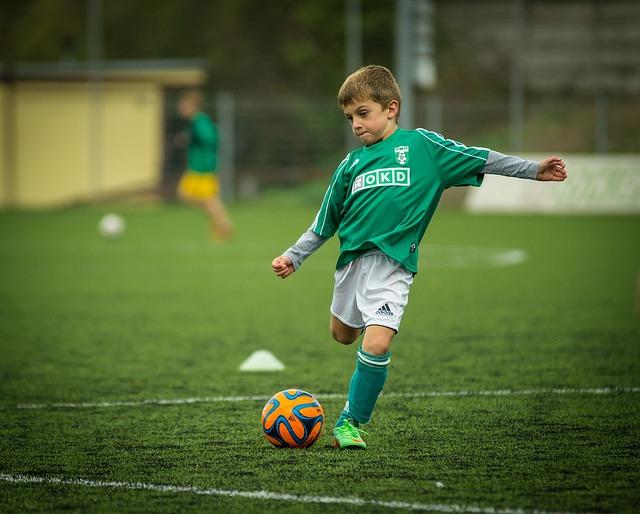Post-Surgery Play: Can You Play Soccer After ACL Surgery?
So, you’ve recently undergone ACL surgery and now you’re wondering if you’ll ever be able to get back on the soccer field. Well, the good news is that with proper rehabilitation and guidance, it is possible to return to playing soccer after ACL surgery. Let’s take a closer look at what post-surgery play entails and how you can safely get back to doing what you love.
Contents
- 1 Is Soccer Safe After ACL Surgery?
- 2 Recovery Timeline for ACL Surgery Patients
- 3 Can You Play Soccer After ACL Surgery?
- 4 Physical Therapy and Exercise Guidelines for Soccer Players
- 5 Risks and Benefits of Returning to Soccer Post-ACL Surgery
- 6 Consulting with Your Orthopedic Surgeon Before Resuming Play
- 7 Importance of Proper Warm-up and Cool-down in Preventing Injuries
- 8 Tips for Strengthening ACL and Preventing Recurrence
- 9 Listening to Your Body: Knowing When to Rest and Recover
- 10 Building Confidence and Trust in Your Knee Post-Surgery
- 11 Future Outlook
Is Soccer Safe After ACL Surgery?
After undergoing ACL surgery, many athletes wonder if they will ever be able to return to playing soccer. The good news is that with the right treatment and rehabilitation, it is possible to get back on the field and continue playing the sport you love. Here’s what you need to know about playing soccer after ACL surgery:
Rehabilitation is Key: Proper rehabilitation is essential for a successful return to soccer after ACL surgery. Working with a physical therapist to strengthen the muscles around your knee, improve flexibility, and regain range of motion is crucial in preventing re-injury.
Gradual Return to Play: It’s important to ease back into playing soccer after ACL surgery. Starting with light jogging, then progressing to running, cutting, and jumping activities can help you build up the strength and stability needed to play safely.
Protective Bracing: Some athletes choose to wear a knee brace for added support and stability when returning to soccer after ACL surgery. While not always necessary, a brace can provide peace of mind and help prevent re-injury on the field. Be sure to consult with your doctor before using a brace.
Recovery Timeline for ACL Surgery Patients
Can You Play Soccer After ACL Surgery?
After undergoing ACL surgery, it is crucial for patients to follow a recovery timeline to ensure a successful rehabilitation process. While playing soccer may be a beloved sport for many, it is essential to understand the limitations and considerations for returning to play post-surgery.
Here is a general overview of the :
- Weeks 1-2: Focus on pain management, reducing swelling, and regaining range of motion through physical therapy.
- Weeks 3-6: Begin weight-bearing exercises, strengthening the muscles around the knee, and improving balance and coordination.
- Weeks 7-12: Continue with strength training, progress to light jogging, and work on agility and proprioception.
- Months 4-6: Increase the intensity of exercises, introduce cutting and pivoting movements, and start sport-specific training.
| Activity | Timeline |
|---|---|
| Light jogging | Weeks 7-12 |
| Cutting and pivoting | Months 4-6 |
It is important to consult with your medical team, including your surgeon and physical therapist, before returning to play soccer or any other high-impact sport. They will assess your progress, evaluate your knee stability, and guide you on the appropriate time to resume playing.
Physical Therapy and Exercise Guidelines for Soccer Players
After undergoing ACL surgery, it is crucial for soccer players to follow proper physical therapy and exercise guidelines to ensure a safe return to the field. While the road to recovery may be challenging, with dedication and patience, players can get back to playing the sport they love.
Here are some important tips to keep in mind when returning to play soccer after ACL surgery:
- Start Slow: Begin with light exercises and gradually increase intensity to avoid putting too much strain on the knee.
- Focus on Strength Training: Building up the muscles surrounding the knee can help provide stability and support during gameplay.
- Improve Flexibility: Incorporate stretching exercises to improve range of motion and prevent future injuries.
Remember to consult with your physical therapist or healthcare provider for personalized recommendations based on your specific needs and recovery progress. By following these guidelines and staying committed to your rehabilitation plan, you can get back to playing soccer with confidence.
Risks and Benefits of Returning to Soccer Post-ACL Surgery
Returning to soccer after ACL surgery can be a daunting decision, filled with both risks and benefits. It’s important to weigh these factors carefully before getting back on the field.
Risks:
- Re-Injury: Without proper rehabilitation and caution, there is a risk of re-injuring the reconstructed ACL.
- Decreased Performance: It may take time to regain strength and agility, impacting your performance on the field.
Benefits:
- Improved Stability: ACL surgery can provide better stability and lower the risk of knee instability during play.
- Confidence Boost: Getting back to the sport you love can provide a significant confidence boost and sense of accomplishment.
| Factor | ACL Surgery Post-Op |
|---|---|
| Risk | Re-Injury |
| Risk | Decreased Performance |
| Benefit | Improved Stability |
| Benefit | Confidence Boost |
Consulting with Your Orthopedic Surgeon Before Resuming Play
Before you lace up your cleats and hit the soccer field after ACL surgery, it’s crucial to consult with your orthopedic surgeon. Your surgeon is familiar with your specific case and can provide personalized advice on when it’s safe to resume play. Here are some key points to discuss during your consultation:
– **Recovery Progress:** Your surgeon will assess your progress post-surgery to determine if your knee is strong enough to handle the demands of playing soccer. They may recommend certain exercises or physical therapy to further strengthen your knee before returning to play.
– **Risk of Re-Injury:** ACL surgery requires significant recovery time to reduce the risk of re-injury. Your surgeon can provide insights on how playing soccer may impact your knee and the potential risk of re-injury if you return to the sport too soon.
– **Guidelines for Return to Play:** Your surgeon can outline specific guidelines for when it’s safe to return to playing soccer. They may recommend starting with light training sessions and gradually increasing intensity to avoid any setbacks.
– **Monitoring Progress:** It’s essential to keep your surgeon updated on your progress and any pain or discomfort you may experience while playing soccer. Regular check-ins will help ensure a smooth recovery and reduce the risk of complications.
Remember, always follow your surgeon’s advice and listen to your body when considering a return to play after ACL surgery. Your health and safety should be the top priority as you work towards getting back on the field.
Importance of Proper Warm-up and Cool-down in Preventing Injuries
Proper warm-up and cool-down routines are essential for any athlete, especially those recovering from ACL surgery.
During a warm-up, athletes should focus on increasing blood flow to the muscles, improving flexibility, and preparing the body for physical activity. This can help prevent injuries by reducing the risk of muscle strains and tears.
Similarly, a thorough cool-down is important for allowing the body to gradually return to its resting state. This can help prevent muscle stiffness and soreness, as well as reducing the risk of long-term injuries.
Incorporating dynamic stretches, light cardiovascular activity, and foam rolling into your warm-up and cool-down routines can significantly improve your recovery process and help you get back to playing soccer safely after ACL surgery. Remember, consistency is key!
Tips for Strengthening ACL and Preventing Recurrence
Playing soccer after ACL surgery can be a feasible goal, but it’s essential to approach it with caution and follow proper guidelines to prevent injury and ensure a successful recovery. Here are some tips to strengthen your ACL and reduce the risk of recurrence:
**1. Proper Rehabilitation:** Following a structured rehabilitation program, as prescribed by your physical therapist or healthcare provider, is crucial for rebuilding strength, flexibility, and stability in your knee. This will help to prevent reinjury and improve your overall function.
**2. Focus on Strength Training:** Incorporate exercises that target the muscles surrounding your knee, including the quadriceps, hamstrings, and calves. Building strength in these muscles can help provide support and stability to your knee joint, reducing the strain on your ACL.
**3. Improve Balance and Proprioception:** Balance and proprioception exercises can help enhance your coordination and body awareness, reducing the risk of falls and twisting motions that can put stress on your ACL. Consider adding activities like single-leg stands, wobble board exercises, and agility drills to your routine.
**4. Gradual Return to Activity:** When considering returning to soccer or any high-impact sport, it’s essential to ease back into activity gradually. Start with low-impact exercises, such as biking or swimming, before progressing to more intense activities like running and cutting. Listen to your body and consult with your healthcare provider before returning to full play.
By following these tips and prioritizing your recovery, you can increase your chances of playing soccer safely after ACL surgery and minimize the risk of reinjury. Remember to stay patient and consistent with your rehabilitation efforts to ensure long-term success on the field.
Listening to Your Body: Knowing When to Rest and Recover
After undergoing ACL surgery, it is important to listen to your body and know when to rest and recover. One common question that many athletes have is whether they can return to playing soccer after undergoing this type of surgery. While the answer may vary depending on your specific situation, there are some general guidelines to consider.
Factors to consider:
- The type of ACL surgery you had
- Your overall physical condition and fitness level
- Your level of pain and discomfort
- Rehabilitation progress and recommendations from your healthcare provider
It is crucial to consult with your healthcare provider before returning to any physical activity, including playing soccer. They will be able to assess your progress and provide guidance on when it is safe to resume playing sports. Remember that rushing back into intense physical activity too soon can jeopardize your recovery and potentially lead to further injury.
Building Confidence and Trust in Your Knee Post-Surgery
Understanding Your Recovery Timeline:
After undergoing ACL surgery, it’s important to be patient with your recovery process. takes time, so it’s essential to follow your doctor’s instructions and stay committed to your rehabilitation program. Keep in mind that every individual heals at a different pace, so don’t compare your progress to others.
Returning to Physical Activities:
While soccer is a high-impact sport, it’s possible to gradually reintroduce it into your routine after ACL surgery. However, it’s crucial to consult with your healthcare provider before engaging in any physical activities. Start by focusing on low-impact exercises and gradually progress to more demanding movements as your knee strengthens.
Tips for Playing Soccer Safely:
- Wear a knee brace for added support during physical activities
- Warm-up properly before playing soccer to prevent injuries
- Avoid sudden pivoting or twisting movements that could strain your knee
- Listen to your body and stop if you experience any pain or discomfort
Future Outlook
In conclusion, while ACL surgery may temporarily sideline you from playing soccer, with proper rehabilitation and guidance from medical professionals, you can safely return to the pitch. Remember to prioritize your recovery and follow all post-op guidelines to ensure a successful and enjoyable return to the beautiful game. Good luck, and keep kicking!















